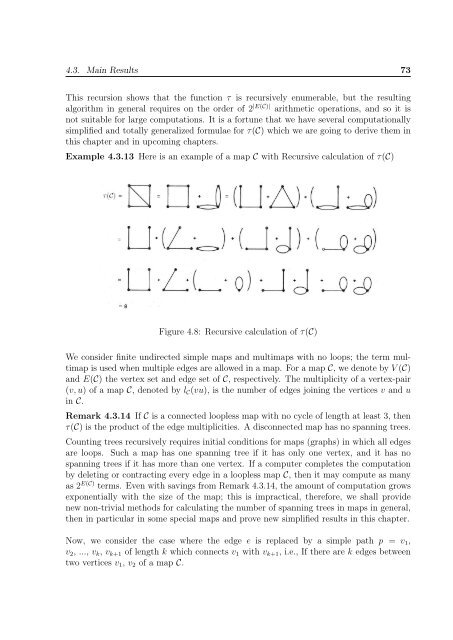enumeration of the number of spanning trees in some ... - Toubkal
enumeration of the number of spanning trees in some ... - Toubkal
enumeration of the number of spanning trees in some ... - Toubkal
Create successful ePaper yourself
Turn your PDF publications into a flip-book with our unique Google optimized e-Paper software.
4.3. Ma<strong>in</strong> Results 73This recursion shows that <strong>the</strong> function τ is recursively enumerable, but <strong>the</strong> result<strong>in</strong>galgorithm <strong>in</strong> general requires on <strong>the</strong> order <strong>of</strong> 2 |E(C)| arithmetic operations, and so it isnot suitable for large computations. It is a fortune that we have several computationallysimplified and totally generalized formulae for τ(C) which we are go<strong>in</strong>g to derive <strong>the</strong>m <strong>in</strong>this chapter and <strong>in</strong> upcom<strong>in</strong>g chapters.Example 4.3.13 Here is an example <strong>of</strong> a map C with Recursive calculation <strong>of</strong> τ(C)Figure 4.8: Recursive calculation <strong>of</strong> τ(C)We consider f<strong>in</strong>ite undirected simple maps and multimaps with no loops; <strong>the</strong> term multimapis used when multiple edges are allowed <strong>in</strong> a map. For a map C, we denote by V (C)and E(C) <strong>the</strong> vertex set and edge set <strong>of</strong> C, respectively. The multiplicity <strong>of</strong> a vertex-pair(v, u) <strong>of</strong> a map C, denoted by l C (vu), is <strong>the</strong> <strong>number</strong> <strong>of</strong> edges jo<strong>in</strong><strong>in</strong>g <strong>the</strong> vertices v and u<strong>in</strong> C.Remark 4.3.14 If C is a connected loopless map with no cycle <strong>of</strong> length at least 3, <strong>the</strong>nτ(C) is <strong>the</strong> product <strong>of</strong> <strong>the</strong> edge multiplicities. A disconnected map has no <strong>spann<strong>in</strong>g</strong> <strong>trees</strong>.Count<strong>in</strong>g <strong>trees</strong> recursively requires <strong>in</strong>itial conditions for maps (graphs) <strong>in</strong> which all edgesare loops. Such a map has one <strong>spann<strong>in</strong>g</strong> tree if it has only one vertex, and it has no<strong>spann<strong>in</strong>g</strong> <strong>trees</strong> if it has more than one vertex. If a computer completes <strong>the</strong> computationby delet<strong>in</strong>g or contract<strong>in</strong>g every edge <strong>in</strong> a loopless map C, <strong>the</strong>n it may compute as manyas 2 E(C) terms. Even with sav<strong>in</strong>gs from Remark 4.3.14, <strong>the</strong> amount <strong>of</strong> computation growsexponentially with <strong>the</strong> size <strong>of</strong> <strong>the</strong> map; this is impractical, <strong>the</strong>refore, we shall providenew non-trivial methods for calculat<strong>in</strong>g <strong>the</strong> <strong>number</strong> <strong>of</strong> <strong>spann<strong>in</strong>g</strong> <strong>trees</strong> <strong>in</strong> maps <strong>in</strong> general,<strong>the</strong>n <strong>in</strong> particular <strong>in</strong> <strong>some</strong> special maps and prove new simplified results <strong>in</strong> this chapter.Now, we consider <strong>the</strong> case where <strong>the</strong> edge e is replaced by a simple path p = v 1 ,v 2 , ..., v k , v k+1 <strong>of</strong> length k which connects v 1 with v k+1 , i.e., If <strong>the</strong>re are k edges betweentwo vertices v 1 , v 2 <strong>of</strong> a map C.

















